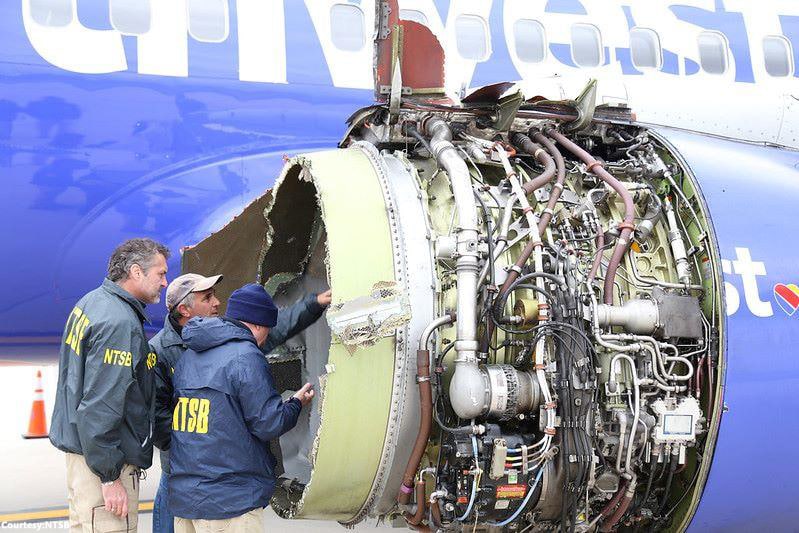Airlines
“Boeing’s Comprehensive Nacelle Redesign: Strengthening Aircraft Safety

The 737 Next Generation (737NG) nacelle design has undergone a thorough modification by Boeing, with the goal of improving the aircraft’s resistance to broken fan blades. To address human-caused failures, including accidentally unlatched doors, the aerospace giant has indicated a need for prolonged deadlines, according to a report.
In a recent regulatory filing dated July 19, Boeing reaffirmed its commitment to meeting the FAA’s upcoming July deadline for introducing design changes. This action was motivated by two safety incidents involving Southwest Airlines 737-700s in which detachable nacelle pieces caused unexpected aircraft damage.
The NTSB suggested that the FAA mandate redesigns of the 737NG-family nacelle that take into account analytical modelling established since the aircraft was certified in the 1990s, and then see to it that the improvements are retrofitted on the 737NG fleet. This recommendation was made in 2019. The FAA and Boeing have been cooperating for almost four years.
Boeing stated in its most recent filing that by July 31, 2023, it would have submitted all design modifications to the FAA and would have issued service bulletins to provide inlet, fan cowl, fan cowl support beam, and exhaust structure modifications for retrofit of these modifications.
Southwest Airlines B 737’s Engine inlet torn away in flight.(Opens in a new browser tab)
Boeing has determined that an extra 17 months will be required to develop a corrective strategy for these maintenance problems. The company is satisfied that its nacelle modifications adhere to the relevant Part 25 requirements.
As a result of the two FBO accidents, one of which had fatal repercussions and resulted in a passenger losing their life, engine manufacturer CFM modified inspection standards and blade life restrictions. These new procedures are a complement to those changes. Boeing has explained its plan to the FAA, highlighting the fact that their combined efforts are intended to reduce the possibility and effects of future FBO accidents.

Airlines
Sanctions & Engine Issues Ground Half of Russia’s A320neo fleet

Russia’s aviation sector, already strained by Western sanctions, faces another setback as nearly half of its Airbus A320neo family aircraft are grounded due to unresolved engine issues.
This development highlights the growing challenges for russia commercial aircraft in maintaining their fleets under the weight of global restrictions and limited access to spare parts.
Out of the 66 Airbus A320neo and A321neo jets in Russia, 34 are now out of service, according to the Kommersant business newspaper. These planes are powered by engines manufactured by Pratt & Whitney, a subsidiary of RTX Corporation.
DAMAC Air: Dubai’s New Luxury Airline Offers Free Flights for Registration
The engines are affected by a previously identified defect in the metal used for certain parts, prompting accelerated inspections and maintenance.
Sanctions have compounded the issue, blocking the supply of essential components from major manufacturers like Boeing and Airbus. Without proper maintenance, experts warn that these aircraft may face decommissioning as early as 2026.
COMAC Unveils Plans for the C929 to Rival Airbus and Boeing
Airlines like S7, which operates a significant portion of these grounded jets, plan to conserve the engines for future use during peak travel seasons. However, reports suggest that over 20 of S7’s Airbus planes have engines that have already reached the end of their operational lifespan. Recently, russia seeks assistance from kazakhstan’s airlines to bolster its domestic flights.
While some A320neo and A321neo planes in Russia are equipped with French-made LEAP engines, which are seen as less problematic, the challenges remain daunting.
The situation underscores the long-term impact of sanctions on Russia’s aviation sector and the increasing difficulties in keeping its modern fleets operational.
-

 Aviation2 months ago
Aviation2 months agoMicrosoft Flight Simulator Raises $3 Million to Bring Back the An-225 Mriya
-

 Airlines2 months ago
Airlines2 months agoQantas Engineers Stage Walkout Over Cost of Living Concerns
-

 Airlines2 months ago
Airlines2 months agoQatar Citizens Can Travel to the United States Without a Visa
-

 Aviation2 months ago
Aviation2 months agoQatar Airways bans these new Electronic Devices on plane
-

 Airlines2 months ago
Airlines2 months agoJapan Airlines Rolls Out Free Domestic Flights to International Passengers
-

 Defence2 months ago
Defence2 months agoWhich Country Has the Largest Fleet of Fighter Aircraft?
-

 Airport2 months ago
Airport2 months agoWestern Sydney Airport Welcomes Its First Plane After 6 Years of construction
-

 Aviation2 months ago
Aviation2 months agoDid you know ? Once Boeing 747 carried 1088 passenger in 1991








